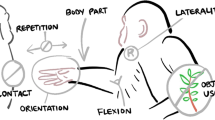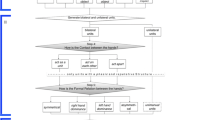Abstract
This paper describes the use of video to explore cultural differences in gestures. Video recordings were used to capture a large sample of international gestures, and these are edited into a documentary video, A World of Gestures: Culture and Nonverbal Communication. This paper describes the approach and methodology used. A number of specific questions are examined: Are there universally understood hand gestures?; Are there universal categories of gestures—i.e., universal messages with unique instances in each society?; Can the exact same gesture have opposite meanings in two cultures?; Can individuals articulate and explain the gestures common in their culture?; How can video methods provide “visual replication” of nuanced behaviors such as gestures?; Are there gender differences in knowing or performing gestures?; and finally, Is global diversity collapsing toward Western gestural forms under the onslaught of cultural imperialism? The research findings suggest that there are both cultural “differences” and also cultural “meta-differences”—more profound differences involving deeply embedded categories of meaning that make cultures unique.
Similar content being viewed by others
REFERENCES
Archer, D. “A World of Gestures: Culture and Nonverbal Communication.” (video) Berkeley: University of California Extension Center for Media and Independent Learning—2000 Center Street, Fourth Floor, Berkeley, California 94704, Phone (510) 642-0460; Fax (510) 643-9271.
Archer, D. and Akert, R. M. 1977. Words and everything else: Verbal and nonverbal cues in social interpretation. Journal of Personality and Social Psychology, 35, 443–449.
Archer, D. and Akert, R. M. 1980. The encoding of meaning: A test of three theories of social interaction. In D. H. Zimmerman and C. West (Eds.), Language and Social Interaction, a special issue of Sociological Inquiry, 50, 393–419.
Archer, D. and Akert, R. M. The Interpretation of Behavior. Verbal and Nonverbal Factors in Person Perception. New York: Cambridge University Press (in preparation).
Archer, D., Akert, R., and Costanzo, M. 1993. The accurate perception of nonverbal behavior: Questions of theory and research design. In P. D. Blanck (Ed.), Interpersonal Expectations: Theory, Research, and Application. New York: Cambridge University Press, 242–260.
Bateson, G. 1972. Steps to an Ecology of Mind. 1972. New York: Ballantine Books.
Bateson, G. and Mead, M. 1942 (reprinted 1962). Balinese Character. A Photographic Analysis. New York: New York Academy of Sciences.
Birdwhistell, R. L. 1970. Kinesics and Context: Essays on Body Motion. Philadelphia: University of Pennsylvania Press.
Collier, J. and Collier, M. 1986. Visual Anthropology: Photography as a Research Method. Albuquerque: University of New Mexico Press.
Costanzo, M. and Archer, D. 1989. Interpreting the expressive behavior of others: The Interpersonal Perception Task. Journal of Nonverbal Behavior, 13, 225–245.
Ekman, P. 1976. Movements with precise meanings. Journal of Communication, 26, 14–26.
Ekman, P. and Friesen. W. V. 1972. Hand movements. Journal of Communication, 22, 353–374.
Hall, E. T., 1959. The Silent Language. Garden City, N.Y.: Doubleday.
Hall, E. T. 1969. The Hidden Dimension. Garden City, N.Y.: Anchor Books.
Hall, E. T., 1981. Beyond Culture. Garden City, N.Y.: Anchor Books.
Klima, E. S., and Bellugi, U., 1979. The Signs of Language. Cambridge, Mass.: Harvard University Press.
Morris, D., 1977. Manwatching: A Field Guide to Human Behavior. New York: Abrams.
Morris, D., 1994. Bodytalk: A World Guide To Gestures. London: Jonathan Cape.
Morris, D., Collett, P., Marsh, P., and O'Shaughnessy, M. 1979. Gestures: Their Origins and Distribution. London: Jonathan Cape.
Rosenthal, R., Hall, J. A., DiMatteo, M. R., Rogers, P. L., and Archer, D. 1979. Sensitivity to Nonverbal Communication: The PONS Test. Baltimore: Johns Hopkins University Press.
Sacks, O. W., 1990. Seeing Voices: A Journey into the World of the Deaf. New York: HarperCollins.
Sapir, E. 1949. The unconscious patterning of behavior in society. In D. G. Mandelbaum (Ed.), Selected Writings of Edward Sapir in Language, Culture, and Personality. Berkeley: University of California Press.
Smith, H. J., Archer, D., and Costanzo, M. 1991. “Just a hunch”: Accuracy and awareness in person perception. Journal of Nonverbal Behavior, 15, 3–18.
Wagner, J. (Ed.), 1979. Images of Information: Still Photography in the Social Sciences. Beverly Hills, CA.: Sage Publications.
Wylie, Laurence and Rick Stafford, 1977. Beaux Gestes: A Guide to French Body Talk. New York: Dutton.
Author information
Authors and Affiliations
Rights and permissions
About this article
Cite this article
Archer, D. Unspoken Diversity: Cultural Differences in Gestures. Qualitative Sociology 20, 79–105 (1997). https://doi.org/10.1023/A:1024716331692
Issue Date:
DOI: https://doi.org/10.1023/A:1024716331692




